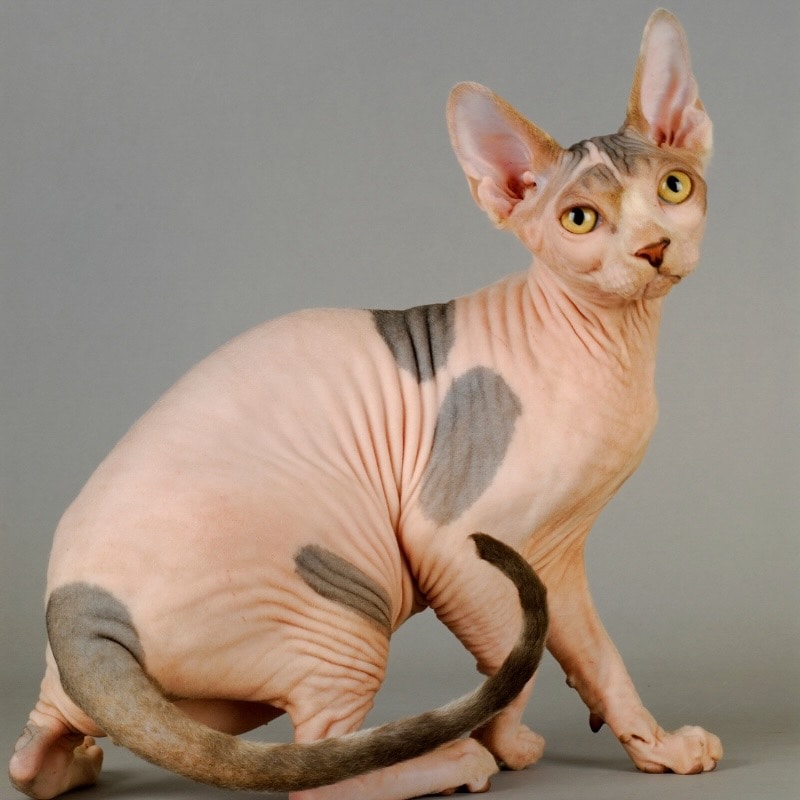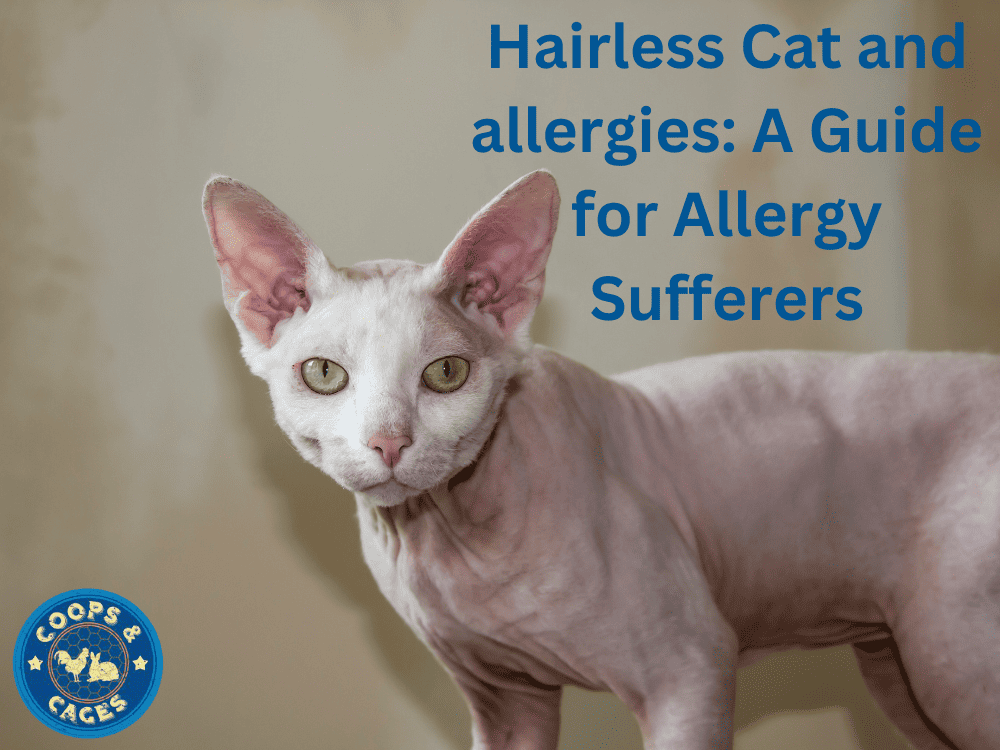Cats, Interesting
Hairless Cat and Allergies: A Guide for Allergy Sufferers
Ever heard of the connection between a hairless cat and allergies? Intriguing, isn’t it?
Imagine having a purring feline friend curled up on your lap – only without the sneezing fits or itchy eyes you’ve come to dread from cat hair. Sounds like wishful thinking? Not quite!
We’re about to dive in and see if certain cat breeds might just let you enjoy their company without triggering those pesky allergy symptoms.
Curious about these hypoallergenic cats and if they could be right for you? Join me as we explore the possibility of a hairless cat and allergies!
- The Science Behind Cat Allergies
- How Hairless Cats Impact Allergies
- Hypoallergenic Cat Breeds Overview
- Common Characteristics of Hypoallergenic Cats
- In-depth Look at Sphynx Cats
- The Unique Features of Sphynx Cats
- Tips for Living with a Hairless or Hypoallergenic Cat
- FAQs in Relation to Hairless Cat and Allergies
- Jordan’s Wrap
The Science Behind Cat Allergies
Fel d 1 is the name of a protein produced by cats, primarily found in their saliva and sebaceous glands, it is transferred to cat’s fur through licking and is a common allergen that can trigger allergic reactions in some people.
Cats produce this allergenic protein in their saliva and dead skin cells, which then spreads throughout your home on cat hair. Interestingly enough, as many as three in ten people with allergies are allergic to cats or dogs.
But here’s a twist: cat allergies are about twice as common as dog allergies. This is likely because cats groom themselves more often than dogs do.
How Hairless Cats Impact Allergies
You might think getting a hairless Sphynx would fix your problem. After all, no cat hair means less spread of allergens around your house right? Not exactly.
Hairless sphynx cats still produce Fel d 1 protein like any other feline friend; they just don’t have the same amount of fur for it to cling onto before being spread around by shedding or grooming activities.
Hypoallergenic Cat Breeds Overview
Picking a hypoallergenic kitty can be an immense help for cat allergy sufferers. No cat breed is completely free from allergens, however, some breeds produce fewer allergens.
Devon Rex and Cornish Rex
The Devon Rex and Cornish Rex cats are unique due to their curly coats. These breeds’ fine hair produces fewer allergens, which can bring relief to those with allergies. With their playful personalities and low allergen levels, they make great companions for sensitive owners.
But it doesn’t stop there. The Devon Rexes require minimal grooming compared to other breeds, while the Cornish variety has even less fur, making them good choices too.
Oriental Shorthair and Russian Blue
The Oriental Shorthair is another breed known for its sleek coat that requires minimal grooming, which can reduce dander spread around your home.
Russian Blues also carry this trait but offer something more special – they produce lower levels of Fel d 1 protein than most cats do; this protein being the main cause of allergic reactions in humans according to studies.
Common Characteristics of Hypoallergenic Cats
Less Dander Production
Hypoallergenic cats may produce less dander or have coats that are less likely to trap and release dander into the environment.
Distinctive Coat Types
Certain breeds with specific coat characteristics, such as Cornish Rexes or Sphynx, are often labeled as hypoallergenic due to their unique fur qualities.
Low Shedding
Breeds with minimal shedding or shorter hair may be considered hypoallergenic, as they can reduce the spread of allergens in the environment.
Gender
A recent study suggests it might also be helpful to choose female or neutered male cats who tend to produce less Fel D 1 than intact males.
It’s essential to recognize that individual reactions to allergens can vary, and while these characteristics may contribute to reduced allergenicity, no cat breed can guarantee complete hypoallergenicity.
It’s important though to spend time with different breeds before bringing one home since sensitivity levels vary among individuals.

In-depth Look at Sphynx Cats
The Sphynx cat, a hairless wonder, is a unique breed known for its lack of coat. These cats produce significantly fewer allergens, making them a great pick for people with allergies.
The Unique Features of Sphynx Cats
Distinctive and endearing in their own right, these hypoallergenic cats sport large ears and a fine layer of downy fuzz instead of fur. Unlike other breeds with layers upon layers of cat hair, Sphynxes have exposed skin which requires frequent bathing to remove oil buildup.
Despite being labelled as ‘hairless’, they are not completely devoid of covering – they possess what can be best described as peach fuzz. Their soft skin feels warm and suede-like to touch because their body heat isn’t insulated by fur.
Sociable creatures that crave human attention, Sphynxes will often go out on a limb to get noticed – including performing acrobatic tricks. But don’t let their playful nature fool you; they also love curling up under the covers for warmth during nap time due to having no natural insulation from cold weather conditions.
Tips for Living with a Hairless or Hypoallergenic Cat
For allergy sufferers, owning a hairless or hypoallergenic cat such as the Sphynx can offer relief from symptoms. But it still needs careful management to keep those sneezes at bay.
Regular Cleaning
Regularly clean areas where your feline friend loves to spend time, as this can help minimise the presence of cat allergens in your home. This includes their favourite couch corner and their cosy bed.
Frequent Bathing
Cats produce a protein called Fel d 1 which is often the cause of allergic reactions. Studies suggest bathing your cat regularly might reduce this allergen level but do check with your vet before starting regular baths as too much could dry out their skin.
Proper Nutrition
Healthy cats tend to produce less dander so ensure they have proper nutrition and regular check-ups.
Regular Brushing
Even if your cat lacks fur like our hairless sphynx friends, brushing them helps remove dead skin cells that carry allergens.
FAQs in Relation to Hairless Cat and Allergies
Do Hairless Cats Trigger Allergies?
Hairless cats, like the Sphynx, can still trigger allergies. This is because allergens come from their saliva and skin, not just fur.
Are Short Hair Cats Worse For Allergies?
No, short-haired cats aren’t necessarily worse for allergies. The severity of allergic reactions depends more on a cat’s individual production of allergens.
What Are The Worst Cats For Allergies?
The “worst” breeds vary based on individuals’ sensitivities.
However, long-haired breeds that groom often may spread more allergens around your home.
Are Siberian Cats Hypoallergenic?
While no cats are entirely hypoallergenic, Siberians are known to produce lower levels of the Fel d 1 protein.
Is There A 100% Hypoallergenic Cat?
Nope. There’s no completely hypoallergenic cat breed out there. Even so-called ‘hypoallergenic’ kitties produce some level of allergy-causing proteins.
Jordan’s Wrap
The connection between a hairless cat and allergies isn’t as simple as ‘no fur equals no sneezes’. We learned that Fel d 1 protein in skin cells is often the real culprit behind allergic reactions.
Hypoallergenic breeds like Sphynx, Devon Rex or Russian Blue might be your best bet if you’re after a feline friend without triggering allergy symptoms.
But remember, there are still allergens involved so spend time with different breeds before making your choice.
Last but not least: grooming matters! Regular brushing for those with fine coats and frequent bathing for our hairless mates helps keep allergen levels low at home.
Cheers to finding your purr-fect companion!



